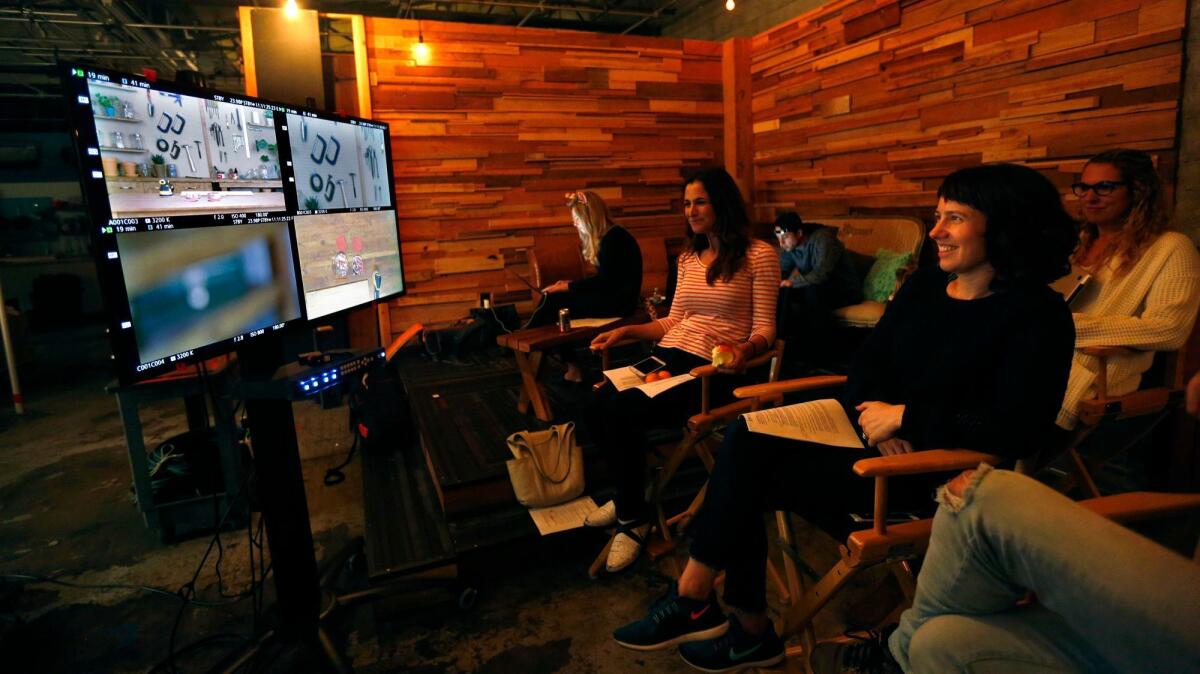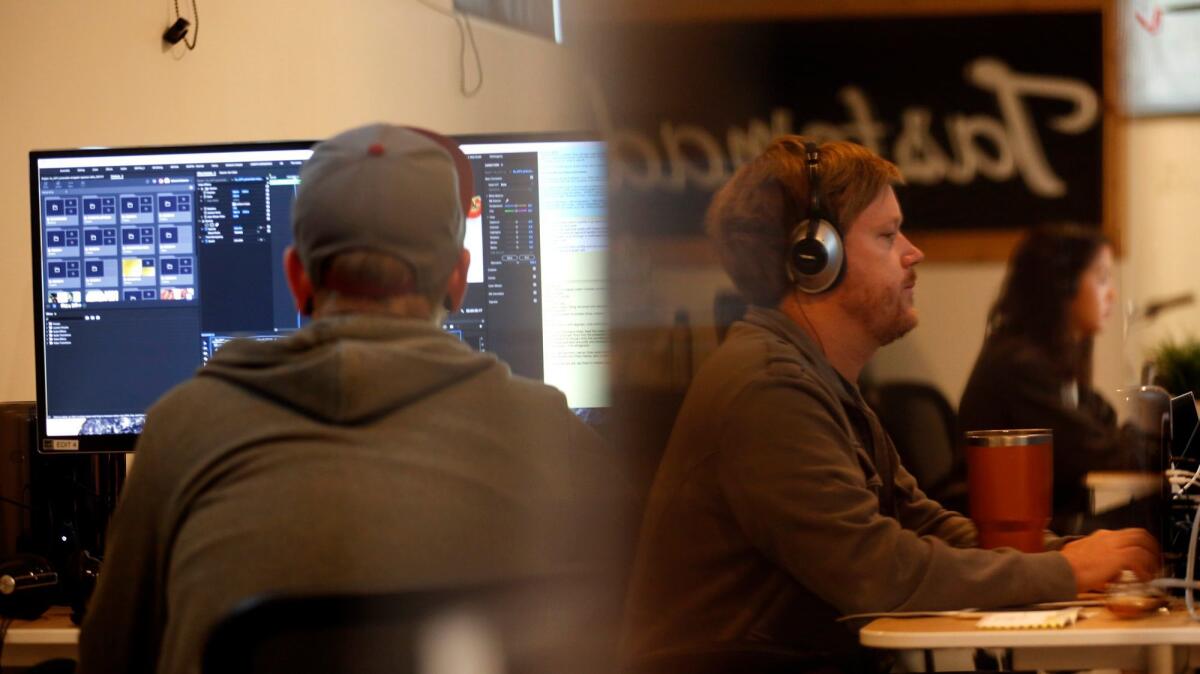Pivoting to video is the biggest trend in media — but it may not prove as lucrative as publishers hope

- Share via
In 2015, BuzzFeed tasked five employees with a single objective: Craft the perfect viral Facebook video.
To ensure maximum share-ability, such a video had to be short — no more than 40 seconds long — and enjoyable either with or without sound as users scrolled their feeds. The team found its solution in how-to-cooking clips, and soon the mouthwatering videos made by its Tasty sub-brand began taking Facebook by storm.
BuzzFeed’s success with Tasty, along with the widespread popularity of rival food channels such as Tastemade and Delish, did not go unnoticed. Much of the media world has since invested in producing short videos to be shared across social media and watched (muted or with sound) on mobile devices. With brands expected to spend $22 billion on video ads in the U.S. by 2022 — a 68% jump from 2017, according to eMarketer — social media platforms likely will be filled with even more quick clips in the years to come.
But as more video creators rush to Facebook, Instagram, Snapchat and YouTube to share their content, the shift to video may prove less lucrative than publishers hope.
Digital publications including Mashable, Uproxx Media Group, Fusion Media Group and Defy Media — all of which have put significant resources toward video — either sold or are looking to sell ownership stakes in their companies, according to various media reports. In addition, Vice, Mic and BuzzFeed each announced layoffs this year after doubling down on video.
“I see digital video as little more than an iteration of the banner ad,” said Pivotal Research advertising analyst Brian Wieser, referring to the easily ignored advertisements atop web pages, which once were core to online publishing but since have yielded diminishing returns.

One issue is that publishers pursuing video are entering into an increasingly crowded marketplace.
As short-form video floods social channels, Wieser said, brands have less incentive to pay higher prices to place the TV-style ads that accompany many videos online. To continue to attract advertisers, Wieser believes publishers will need to create “very high quality” videos, which can be expensive and time-consuming to produce.
Publishers also fear that Facebook and Google — which together eat up 63% of total U.S. advertising dollars spent online, according to eMarketer — eventually could extract an even larger share of the revenue generated from video ads, Wieser said. Each reportedly collects 45% of ad revenue raised by publishers’ videos on their platforms.
“Google and Facebook are taking the vast majority of ad revenue and paying content creators far too little for the value they deliver to users,” BuzzFeed CEO Jonah Peretti wrote in a memo on the state of digital media.
Peretti singled out Tasty for developing a more diversified business model that the rest of BuzzFeed plans to adopt. In addition to monetizing its videos with ads, Tasty has an e-commerce arm with a Tasty-branded cookbook and hot plate stovetop. It’s exploring a TV partnership with NBCUniversal.
If you’re pivoting to video this year, you’re too late.
— Tasty general manager Ashley McCollum
Compared to many short-form video producers, Tasty is insulated from the whims of online advertising because its core business is charging brands to create personalized videos promoting their products. Referred to as branded content, these videos run on Tasty’s popular social channels alongside its non-sponsored videos. So long as they don’t include ads, earnings from the clips don’t have to be shared with Google or Facebook.
Tasty general manager Ashley McCollum said that the channel makes most of its money through branded content — a business model difficult for newcomers to replicate.
“If you’re pivoting to video this year, you’re too late,” McCollum said. “We’ve been building a video business at BuzzFeed for five years and monetizing it from the beginning.”
McCollum said Tasty, along with its home and crafts offshoot Nifty, are the fastest-growing segments within BuzzFeed. Although the company reportedly will miss this year’s revenue goals by up to 20%, it said Tasty’s revenue is on track to grow by 45% in 2017.
When creating a branded video, Tasty takes what it has learned analyzing data gathered from billions of views and applies those insights to help companies reach its coveted millennial audience. A recent video for Samsung shows a young woman selecting music to play on one of the company’s smart refrigerators while preparing tomato-and-mozzarella skewers for a dinner party.
“[Tasty] is able to put together videos that get at the essence of what we’re trying to say about the product,” said Katie Cheng, Samsung’s vice president of marketing. The video proved successful on Facebook, racking up over 9 million views and nearly 10,000 shares on the platform since July.

Branded video content is being produced by media companies ranging from millennial-focused sites such as Vox Media to print stalwarts such as the New York Times. Yet some who follow the industry say there’s a limit to how much revenue branded content ultimately can yield.
“Branded content is not that scalable,” said Allison Stern, co-founder and chief marketing officer of Tubular Labs, a video analytics firm. “That’s the fear.”
Most online ads are programmatic, meaning they are placed in front of web content using algorithms and generate revenue for publishers based on the number of times they are viewed. But with branded content, publishers generally receive a flat fee from an advertiser no matter how many times an ad is seen. While earnings from programmatic ads can grow exponentially, revenue from a branded video — no matter its popularity — is fixed.
Another worry for publishers is that relying on Facebook or the Google-owned YouTube to distribute their videos makes them vulnerable to changes in the social media companies’ platforms.
Views of videos on Tasty’s main Facebook page declined from 1.6 billion in January to just above 1 billion in November, according to Tubular Labs. Increased competition may be to blame. But the diminishing view count also could have been caused by a change in the way Facebook decides which videos appear in users’ feeds.
Stern said as Facebook has rolled out features such as live video and its exclusive video channel Facebook Watch, the company may have tweaked its algorithm to emphasize its own features at the expense of clips uploaded to publisher’s pages. (Facebook said it weighs factors including how long videos are watched and whether people watch them to help populate users’ feeds with content that is “the most personally relevant story to them.”)
A smaller reach on Facebook could drive down the price companies are willing to pay Tasty to create and share branded videos.
As part of a test in six countries in October, Facebook removed videos and articles from users’ main feeds and began showing them on a separate channel. Some publishers reported a significant drop in traffic after the move. While only a test, the shift highlights the limited control publishers ultimately have over how their content is distributed on social media.
Although Facebook’s evolving strategy can cause headaches for publishers, it also can create new opportunities. One of Tasty’s primary competitors, Santa Monica-based Tastemade, recently sold six shows to Facebook for its Watch channel.
One series, called “Struggle Meals,” shows cost-conscious millennials how to prepare dishes for under $2 per serving. Another, called “Little Kitchen,” has kids watch a how-to cooking video before instructing world-class chefs to prepare the same meal.
“We’re a digital video company that started five years ago with a view that all of the biggest social platforms would embrace video,” said Tastemade CEO Larry Fitzgibbon. “And where we find ourselves now is that those social platforms are starting to embrace it.”
As younger audiences eschew traditional television in favor of streaming sites such as Netflix and Amazon, Facebook is aiming to become the next digital hub for original programming. To help realize its ambition, the social media giant reportedly paid as much as $250,000 for longer-form shows and $10,000 to $35,000 for shorter clips. It plans to spend nearly $1 billion on new shows next year, according to a report by the Wall Street Journal.
But even if Facebook spends big on original shows, it may not be enough to meaningfully support the digital video industry at large. The company plans to scale back the number of series it buys for Watch, instead investing in select partnerships with publishers it thinks will drive the most engagement on its platform.
“Facebook is always going to do what’s in Facebook’s best interest,” said Debra Aho Williamson, principal analyst at eMarketer. “It has a lot of control over how and when things are displayed — and in what form and to whom. That’s just the reality of how powerful Facebook is.”
More to Read
Inside the business of entertainment
The Wide Shot brings you news, analysis and insights on everything from streaming wars to production — and what it all means for the future.
You may occasionally receive promotional content from the Los Angeles Times.








